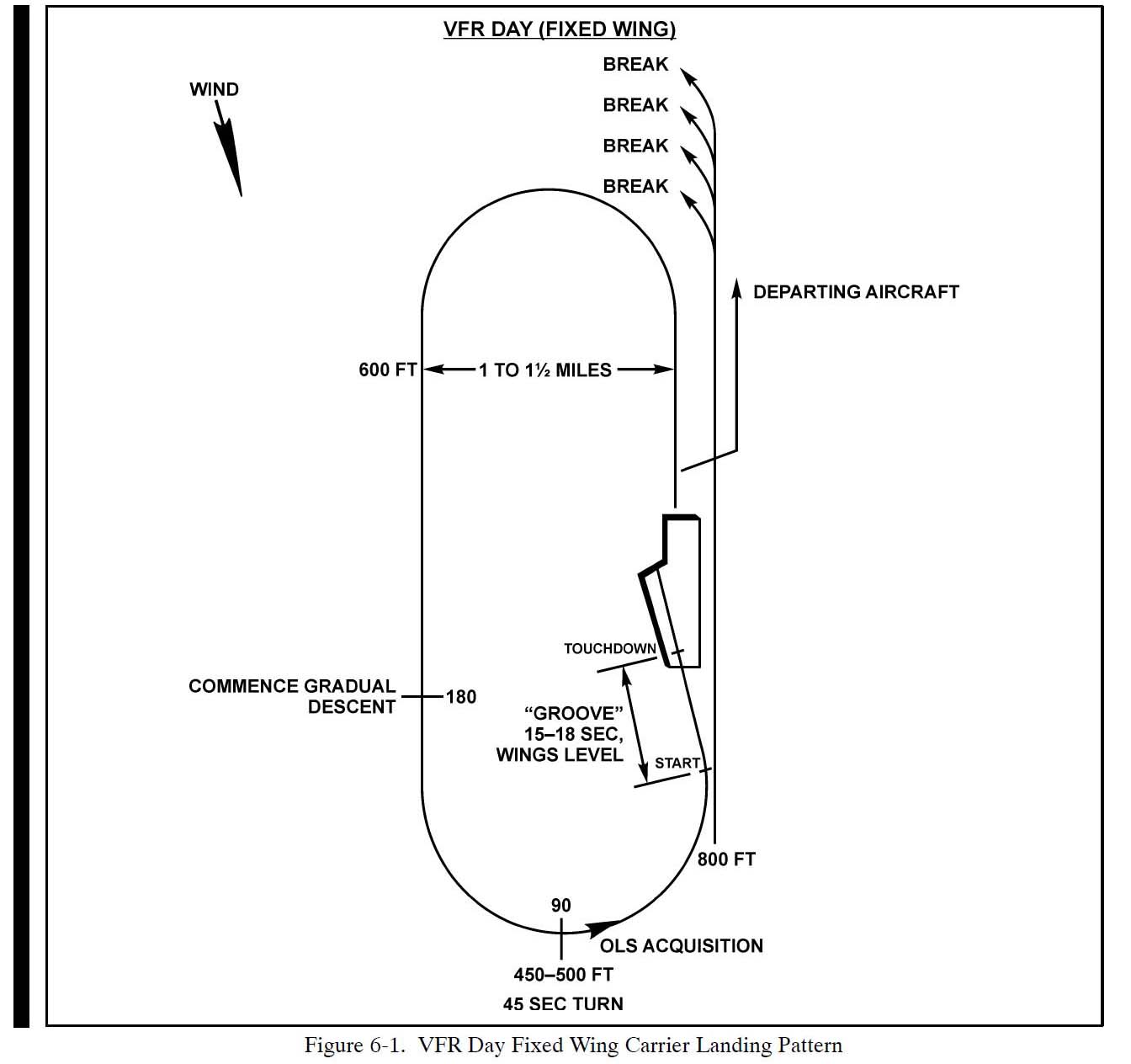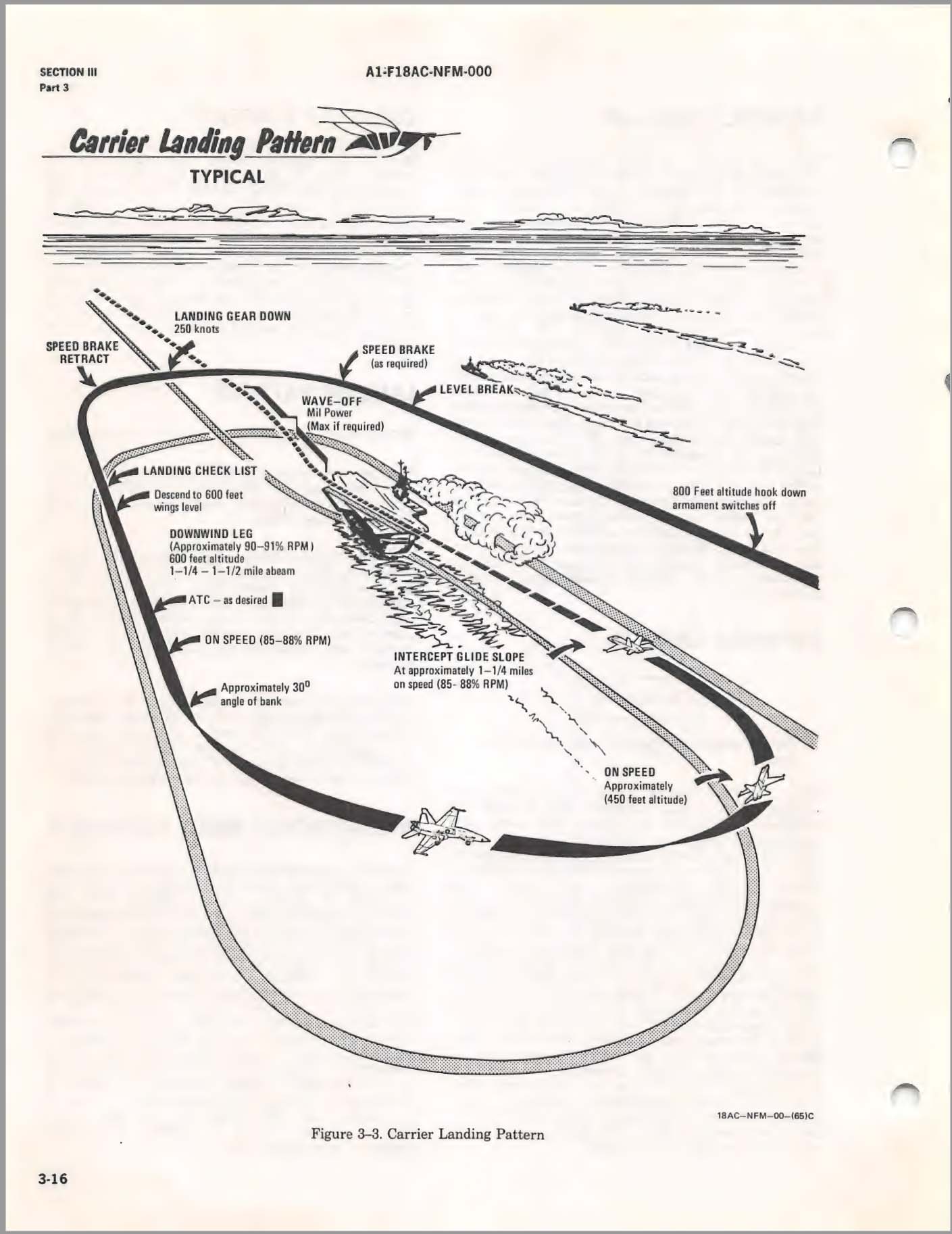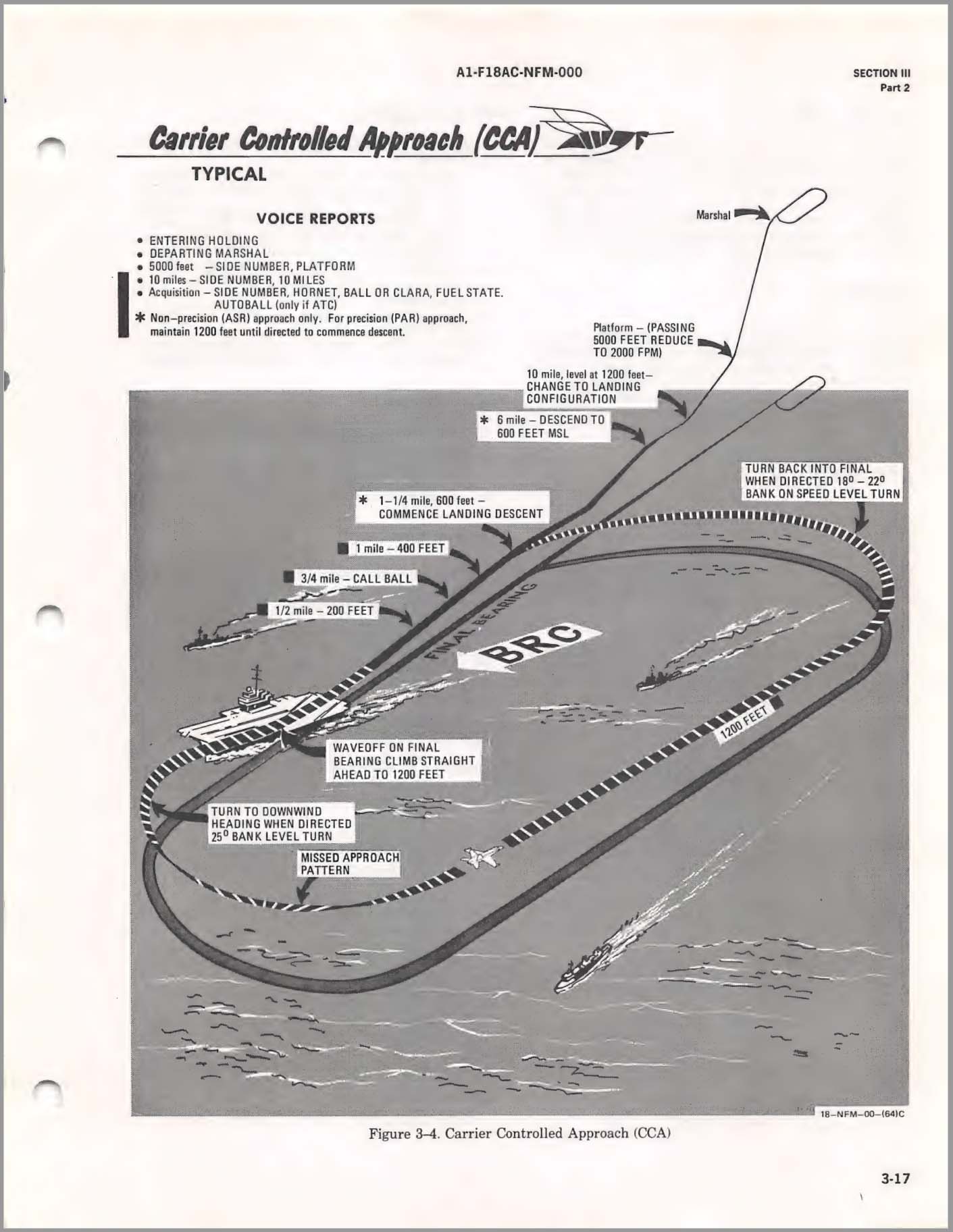IV. Recovery
Recovery CASE I
Landing Pattern
- 800 to 600 FEET
Upon receiving "Charlie" from DCS ATC, flight leaves Port Holding in the manner described in Fig. 1 above. Fight lead calls "initial" at 3 NM astern the carrier and 800 feet ASL. From initial, the flight enters an overhead break at the start of the landing pattern shown in the following figures 6-1 and 3-3.

Enter the carrier landing pattern (figure 3-3) with the hook down. Make a level break from a course parallel to the Base Recovery Course (BRC), close aboard to the starboard of the ship. Below 250 knots lower the gear and flaps. Descend to 600 feet when established downwind and prior to the 180 degree position. Complete the landing checklist and crosscheck angle-of-attack and proper airspeed. With a 30-knot wind over the deck, begin the 180 degree final turn when approximately abeam the round down of the carrier deck. 
Missed Approach / Bolter
- Climb to 600 FEET – Re-enter downwind pattern
Aircraft that are waved off by the LSO or bolter should enter the missed approach pattern.
- Turn to BRC and continue to climb at onspeed AoA to 600 feet.
- Stabilize at 600 feet and observe the downwind pattern for other aircraft.
- Count 15 seconds after passing last aircraft in the downwind then conduct a 30 degree bank turn to downwind heading.
- Fly remainder of approach as per standard Case 1 recovery.
Spin Pattern
- 1200 FEET
A. Purpose
The spin is used to delay aircraft inbound to the overhead break from entering the landing pattern due to congestion from missed approaches. The flight would remain in parade formation, climb to 1200 feet and initiate a left hand orbit at 350 knots at the carrier's bow. Flight lead will monitor the pattern and re-enter the break when safe to do so. Aircraft re-entering the break from the spin pattern have priority over aircraft entering from the port holding pattern. No more than six aircraft can be in spin at the same time.
B. Full pattern at Charlie
- Descend to 1,200 FEET and Spin
The flight leader shall either execute a normal break or spin for all or a portion of his flight, depending upon the number of aircraft in the landing pattern. A spin should normally be initiated at the bow. The spin pattern shall be flown at 1,200 feet within 3 nm of the ship. A maximum of six aircraft shall be in the landing pattern at one time. This number may be modified by the air officer. No aircraft shall break more than 4 miles ahead of the ship.
C. Finding a full pattern after Charlie
- Ascend to 1,200 FEET and enter spin at the bow
Should a Delta be given (or finding the landing pattern is full) after commencing descent from the port holding pattern, but prior to entering the landing pattern, aircraft shall climb or descend as required and enter the spin pattern (1,200 feet) unless specifically directed otherwise. Aircraft in the landing pattern shall continue to maintain proper interval, flying the landing pattern at 600 feet until otherwise directed. Flights directed to spin or reenter the port holding pattern shall climb only on the upwind or crosswind leg ahead of the ship's beam. Aircraft reentering the break from the spin pattern have priority over aircraft entering from the port holding pattern.
D. Re-entering the break
- Descend to 800 FEET at the position 1
When the pattern opens up for flight to enter at the break, flight descends from 1,200 feet into the 800 foot break and into the normal landing pattern described in Fig 6-1 and 3-3.
Voice Reports
Flight leaders shall make the following voice reports.
POSITION REPORT
Descending from the port holding pattern "Commencing" Three miles astern "Initial" Entering spin pattern (when applicable) "Spinning" Departing the landing pattern to reenter port holding "Departing __ nm upwind"
Drag
If a straight-in approach (drag) is requested, it shall be initiated at sufficient distance astern for the aircraft to be established positively on glidepath and approach airspeed at a minimum of 1-1/2 nm for jet/turboprop aircraft.
Recovery CASE II/III:
Make sure landing illumination / taxi lights are off. Position lights and formation lights on. Fly needles straight in to landing. Turn off all exterior lights after landing. Raise flaps, retract / fold wings. Raise hook. Taxi. 
CASE III Missed Approach/Waveoff/Bolter
Jet and turboprop aircraft shall climb straight ahead on the extended final bearing to 1,200 feet altitude and wait for instructions from approach control.
If no instructions are received prior to reaching 4 miles or 2 minutes ahead of the ship, the pilot will attempt to make contact with the ship, giving identification and position. If instructions are not received, he will assume communication failure and execute a turn downwind reporting downwind abeam. If radio contact is not reestablished, he will proceed downwind and reenter as follows:
- Fixed-wing aircraft commence turn to final at the 4 nm DME or 2 minutes past abeam position.
ARRESTMENT AND EXIT FROM LANDING AREA (NIGHT)
During the approach all exterior lights should be on with the exception of taxi/landing light and strobes. Following arrestment, immediately turn the external lights master switch off. Taxi clear of the landing area following the plane director's signals.
V. Comms/Taxi/Parking
Comms: Inter-aircraft Comms shall be on Carrier contact frequency (usually 127.500mhz).
Parking Spots: Due to DCS deck spawning slots and limitations, it is best and universally safest to taxi along side the superstructure. This parking spot can block AI taxi patterns but it does not interfere with AI or player spawn areas.